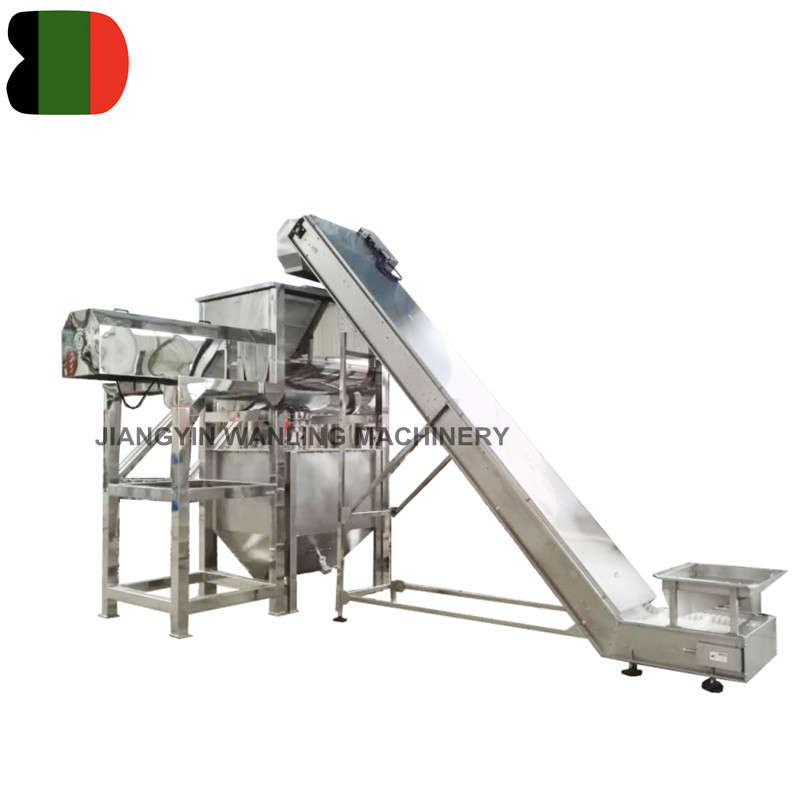Safety is a critical consideration in the design of ribbon blenders, as they are often used in industrial settings where operator safety must be prioritized. Here are some common safety features typically incorporated into the design of ribbon blenders to protect operators:
Interlocking Safety Switches
Description : Interlocks ensure that the blender cannot be started if the lid or access doors are open. Similarly, the lid or access points cannot be opened while the blender is in operation.
Purpose : Prevents accidental exposure to moving parts and ensures that the machine is completely stopped before access is granted.
Emergency Stop Button
Description : A prominently placed emergency stop button allows operators to immediately halt the machine in case of an emergency.
Purpose : Provides quick shutdown capability to prevent accidents or damage.
Guarding of Moving Parts
Description : All moving components, such as ribbons, shafts, and motors, are enclosed within the blender housing or covered with guards to prevent accidental contact.
Purpose : Minimizes the risk of injury from exposed rotating or moving parts.
Overload Protection
Description : The motor and electrical systems are equipped with overload protection devices that automatically shut down the machine if excessive torque or current is detected.
Purpose : Protects both the equipment and operators from potential hazards caused by mechanical or electrical overloads.
Pressure Relief Valves (for Vacuum/Pressure Models)
Description : In blenders designed for vacuum or pressure operation, pressure relief valves are installed to release excess pressure if it exceeds safe limits.
Purpose : Prevents explosions or structural failure due to excessive internal pressure.
Grounding and Electrical Safety
Description : The blender is properly grounded, and all electrical components meet industry standards for safe operation.
Purpose : Reduces the risk of electric shock and ensures compliance with electrical safety regulations.

Access Control Systems
Description : Some advanced models may include key-operated locks or access control systems that restrict operation to authorized personnel only.
Purpose : Ensures that only trained and authorized individuals can operate the blender.
Vibration Isolation
Description : The blender is mounted on vibration isolation pads or frames to reduce vibrations during operation.
Purpose : Prevents excessive noise and potential harm to operators from prolonged exposure to vibrations.
Dust Collection Systems
Description : Integrated dust collection systems capture airborne particles during loading, unloading, or mixing.
Purpose : Protects operators from inhaling harmful dust and maintains a clean working environment.
Material Compatibility and Sanitation
Description : The blender is constructed using materials that are resistant to corrosion and easy to clean, reducing the risk of contamination.
Purpose : Ensures hygiene and prevents cross-contamination, especially in food, pharmaceutical, or chemical applications.
Audible and Visual Alarms
Description : The blender may be equipped with alarms that sound or light up when there is an issue, such as overheating, incorrect operation, or abnormal conditions.
Purpose : Alerts operators to potential dangers or malfunctions before they escalate.
Load Cells and Weight Sensors
Description : Advanced models may include load cells or weight sensors to monitor the amount of material being processed.
Purpose : Prevents overloading, which could lead to mechanical stress, overheating, or unsafe operating conditions.
Temperature Monitoring (Optional)
Description : For processes involving heat-sensitive materials, temperature sensors may be included to monitor and control the internal temperature.
Purpose : Prevents overheating, which could degrade materials or pose a fire hazard.
Training and Documentation
Description : Comprehensive training programs and detailed user manuals are provided to ensure operators understand how to safely operate and maintain the equipment.
Purpose : Educates users on best practices and safety protocols to minimize risks.



 Español
Español














